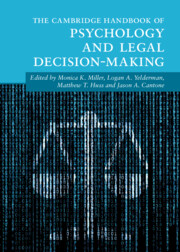Book contents
- The Cambridge Handbook of Psychology and Legal Decision-Making
- Cambridge Handbooks in Psychology
- The Cambridge Handbook of Psychology and Legal Decision-Making
- Copyright page
- Dedication
- Contents
- Figures
- Tables
- Editors
- Contributors
- Part I Introduction Chapters
- Part II Pretrial Phase Decision-Making
- Part III Trial Phase Decision-Making
- Part IV Postconviction Phase Decisions
- 28 Amenability to Treatment Evaluations
- 29 Choosing Between Life and Death
- 30 The Communication of Risk to Legal Decision-Makers
- 31 The Psychology of Parole Decision-Making
- 32 Probation Decision-Making
- 33 Decision-Making in Violence Risk Assessment
- Part V Other Legal Decision-Making
- Part VI Perspectives from the Field
- Part VII Conclusion
- Index
- References
31 - The Psychology of Parole Decision-Making
from Part IV - Postconviction Phase Decisions
Published online by Cambridge University Press: 22 February 2024
- The Cambridge Handbook of Psychology and Legal Decision-Making
- Cambridge Handbooks in Psychology
- The Cambridge Handbook of Psychology and Legal Decision-Making
- Copyright page
- Dedication
- Contents
- Figures
- Tables
- Editors
- Contributors
- Part I Introduction Chapters
- Part II Pretrial Phase Decision-Making
- Part III Trial Phase Decision-Making
- Part IV Postconviction Phase Decisions
- 28 Amenability to Treatment Evaluations
- 29 Choosing Between Life and Death
- 30 The Communication of Risk to Legal Decision-Makers
- 31 The Psychology of Parole Decision-Making
- 32 Probation Decision-Making
- 33 Decision-Making in Violence Risk Assessment
- Part V Other Legal Decision-Making
- Part VI Perspectives from the Field
- Part VII Conclusion
- Index
- References
Summary
This chapter discusses the legal and extralegal factors that affect a parole board member’s decision regarding whether or not to release a prisoner on parole. While some states have mandatory parole, others have discretionary parole, which is the most widely cited process for parole release in the US currently. Discretionary parole allows a board to decide if the prisoner should be released based on statutory factors, which are examined in this chapter. However, they might also be influenced by emotions, biases, public/political pressure, and other extralegal factors. The chapter provides an overview of what these extralegal factors are and how they might affect decisions. The chapter also provides an examination of both parole board member and inmate characteristics that influence release decisions, with a focus on if and how they affect risk assessments. The chapter synthesizes this body of research and offers future directions and implications for the legal field. Future research and/or policy implications are discussed.
- Type
- Chapter
- Information
- The Cambridge Handbook of Psychology and Legal Decision-Making , pp. 476 - 495Publisher: Cambridge University PressPrint publication year: 2024

